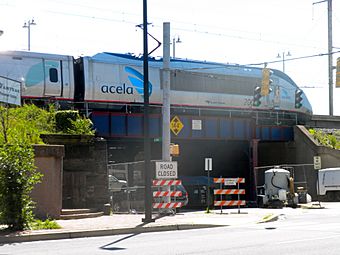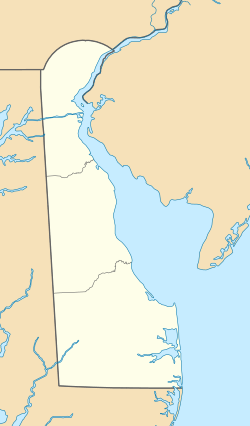Wilmington Rail Viaduct facts for kids
Quick facts for kids |
|
|
Wilmington Rail Viaduct
|
|

Typical plate girder bridge and fill along the viaduct
|
|
| Location | Amtrak's Northeast Corridor through Wilmington, Delaware |
|---|---|
| Area | 11 acres (4.5 ha) |
| Built | 1902 |
| Architectural style | through girder bridges |
| NRHP reference No. | 99001276 |
| Added to NRHP | November 10, 1999 |
The Wilmington Rail Viaduct is a long structure that carries train tracks high above the streets in Wilmington, Delaware. It's like a raised highway for trains. This viaduct is about 4 miles (6.4 km) long. It was built between 1902 and 1908.
The structure is mostly made of earth fills. These fills are held in place by strong stone walls. There are also many steel bridges that cross over city streets. Some parts even have brick arches. The viaduct was built by the Pennsylvania Railroad. It helped make train travel safer and faster. Today, it is listed on the National Register of Historic Places. This means it's an important historical site.
Contents
What the Viaduct Looks Like
The viaduct starts near Vandever Avenue on the east side. It crosses the Brandywine Creek. Then it runs next to the Christina River through the Wilmington Train Station. It ends near the Alban Park neighborhood on the west side.
Earth Fills and Walls
Most of the viaduct is made of packed earth. This earth is held between very strong stone walls. These walls are made of large, cut stones called ashlar. They sit on concrete foundations. Some parts have wooden frames holding the earth. But usually, stone walls are on both sides.
The stone walls also form the supports for the bridges. These bridges carry the train tracks over city streets. They are made of steel girders. A girder is a large beam that supports a structure. The viaduct usually carries three train tracks.
Brick Arches
The west end of the viaduct is different. The ground there was too soft for earth fills. So, engineers built a series of arches instead. They originally planned to use stone. But there wasn't enough stone available. So, they used brick instead.
There are 12 brick arches that carry the tracks. They lead to the Beech Street underpass. Then, 20 more arches continue southwest. The rest of the viaduct at this end goes back to earth fills and retaining walls.
The Brandywine Creek Bridge
The bridge over the Brandywine Creek is a special part of the viaduct. When it was built, this part of the creek was used by boats. So, the railroad had to build a moveable bridge. They chose a swing bridge. This type of bridge can swing open to let boats pass.
Building the bridge was tricky. The first support pillar was damaged by ice and a flood. A new, strong stone and concrete pillar was built. It was 35 feet (10.7 m) wide. Another pillar was built nearby. This created two channels for boats.
The bridge itself was made by the Phoenix Bridge Company. It has a long steel beam that swings open. It carries three train tracks. There were small buildings on the bridge. One was for a watchman. The other held the engine that turned the bridge. This swing bridge opened on March 1, 1906.
Changes Over Time
The viaduct has not changed much since it was built. In the 1920s, the railroad added wires above the tracks. This was for electrification. It allowed electric trains to run. Later, the swing bridge over the Brandywine was fixed in place. It no longer swings open. The engine and control buildings were removed.
In 1955, a new bridge was built under the viaduct. This was for Walnut Street. In 1983, Amtrak fixed up the Poplar Street bridge section.
History of the Viaduct
The original train line through Wilmington was built in 1837. The Pennsylvania Railroad (PRR) took control of it in 1881. In the early 1900s, train traffic grew a lot. More trains meant more problems.
Why the Viaduct Was Built
One big problem was "grade crossings." This is when train tracks cross streets at the same level. As trains got faster and more frequent, these crossings became dangerous. Accidents happened often.
To solve this, the PRR decided to raise the main train line through Wilmington. This would get rid of the dangerous street crossings. It also allowed for a new, modern train station. The railroad's repair shops were also moved. This made more space for the tracks.
Building the Viaduct
The PRR planned to build a double-track structure. It would be held between two tall stone walls. They chose stone because it was strong and looked impressive. The PRR's Chief Engineer, William H. Brown, liked using stone.
Construction started in the spring of 1902. They began near the Wilmington station. Work also started from the east end towards the Brandywine. The project took longer than expected. It even stopped for a while in 1904.
The new swing bridge over the Brandywine opened in March 1906. The first tracks on the new viaduct opened in January 1907. All tracks and the new station were fully open by July 1908.
Electrification and Ownership Changes
In 1926, the PRR announced plans to electrify its lines to Wilmington. This meant electric trains would replace steam trains. Electric train service began in September 1928.
The PRR ran trains over the viaduct until 1968. Then, it merged with another railroad to form the Penn Central Transportation Company. In 1976, Penn Central went bankrupt. The viaduct, along with other important rail lines, was then given to Amtrak. Amtrak still maintains and operates the viaduct today.
Impact on Wilmington
The viaduct changed Wilmington a lot. It showed how important the PRR was. It also created a clear separation between the city and the waterfront. This helped hide the busy industries along the river. Now, as the waterfront is being redeveloped, the viaduct marks one edge of the city's riverfront area.



